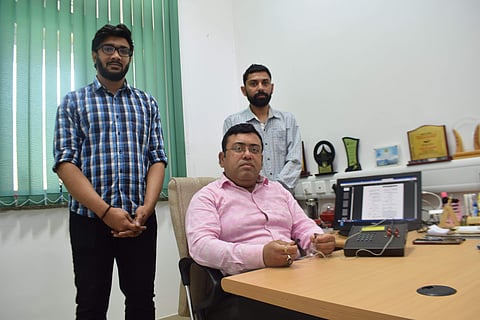These IIT Mandi researchers have invented a technique to easily identify ischemic strokes in patients
A team of researchers from IIT Mandi have invented a new technique to detect abnormal brain characteristics associated with Ischemic Strokes. Associate Professor of the School of Computing and Electrical Engineering, Dr Shubhajit Roy Chowdhury led the project having collaborated with neurologist Abhijit Das from the Institute of Neurosciences, Kolkata and Dr Anirban Dutta, an Assistant Professor in Restorative Neurorehabilitation from the University at Buffalo. The work has been published in IEEE Journal of Translational Engineering in Health and Medicine.
“It is my job to educate people about strokes so they don’t panic,” says Dr Chowdhury, “People, in the villages and cities alike, get confused about what they need to do in the event of a stroke. I try to develop low-cost, handheld gadgets primarily using infrared spectroscopy (measurement of the interaction of infrared radiation with matter) as a mobility which can be used at the point of care. The whole objective is to provide diagnostic support at remote, rural locations where people are generally deprived of healthcare facilities which are normally accessible to people in bigger cities.”
Blood flows through a blood vessel like water would through a rubber tube. In case a blockage arises, water would get obstructed. Arteries get blocked in the very same way. When this occurs, blood fails to reach different tissue, depleting cells in the brain of Oxygen supply, causing them to slowly die. Such a blockage where brain cells die is called an Ischemic Stroke.
“We use infrared spectroscopy to estimate the level of cerebral oxygenation level. In usual tests, oxygen signals have to pass through several layers of muscle, skin, and hair before being picked up by a photodetector. This makes the signal a little weaker. The objective of electric stimulation is to provide direct stimulation which will help in the dilation of blood vessels so more blood can pass through. In case of an Ischemic Stroke, this stimulation cannot be transferred into the blood vessels so you will not see any change in cerebral oxygenation levels. We use this as a biomarker to distinguish between a normal subject or someone who is afflicted by such a stroke,” explains Dr Chowdhury.
In the Indian context, he is hopeful that it will make the most impact in rural areas, “In Himachal, where I currently reside, the villages are very remotely located. In case of a stroke, it is extremely difficult to move the subject to a secondary healthcare centre where you have a CT scan facility. In case of a stroke, the most important thing is to identify what kind of stroke it is within the next three hours and to medicate accordingly. Our invention will simplify this process.” Currently, the team have been granted a US patent for the invention.



